
The magic lantern, also known by its Latin name lanterna magica, is an early type of image projector that used pictures—paintings, prints, or photographs—on transparent plates, one or more lenses, and a light source. Because a single lens inverts an image projected through it, slides were inserted upside down in the magic lantern, rendering the projected image correctly oriented.
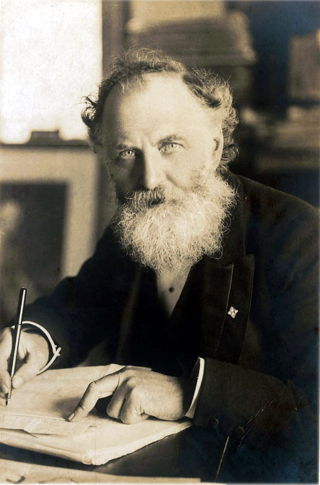
William Thomas Stead was an English newspaper editor who, as a pioneer of investigative journalism, became a controversial figure of the Victorian era. Stead published a series of hugely influential campaigns whilst editor of The Pall Mall Gazette, including his 1885 series of articles, The Maiden Tribute of Modern Babylon. These were written in support of a bill, later dubbed the "Stead Act", that raised the age of consent from 13 to 16.
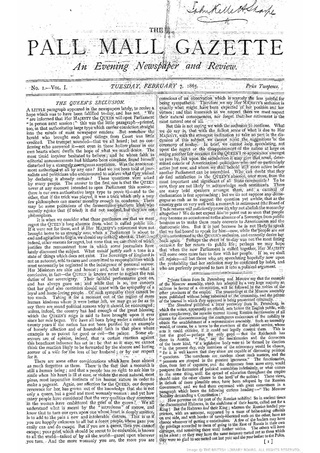
The Pall Mall Gazette was an evening newspaper founded in London on 7 February 1865 by George Murray Smith; its first editor was Frederick Greenwood. In 1921, The Globe merged into The Pall Mall Gazette, which itself was absorbed into The Evening Standard in 1923.

A slide show (slideshow) is a presentation of a series of still images (slides) on a projection screen or electronic display device, typically in a prearranged sequence. The changes may be automatic and at regular intervals or they may be manually controlled by a presenter or the viewer. Slide shows originally consisted of a series of individual photographic slides projected onto a screen with a slide projector. When referring to the video or computer-based visual equivalent, in which the slides are not individual physical objects.

Phantasmagoria, alternatively fantasmagorie and/or fantasmagoria was a form of horror theatre that used one or more magic lanterns to project frightening images, such as skeletons, demons, and ghosts, onto walls, smoke, or semi-transparent screens, typically using rear projection to keep the lantern out of sight. Mobile or portable projectors were used, allowing the projected image to move and change size on the screen, and multiple projecting devices allowed for quick switching of different images. In many shows, the use of spooky decoration, total darkness, (auto-)suggestive verbal presentation, and sound effects were also key elements. Some shows added a variety of sensory stimulation, including smells and electric shocks. Such elements as required fasting, fatigue, and drugs have been mentioned as methods of making sure spectators would be more convinced of what they saw. The shows started under the guise of actual séances in Germany in the late 18th century and gained popularity through most of Europe throughout the 19th century.
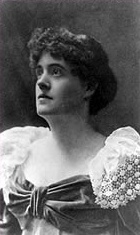
Rosamund Marriott Watson was an English poet, nature writer and critic, who early in her career wrote under the pseudonyms Graham R. Tomson and Rushworth Armytage.
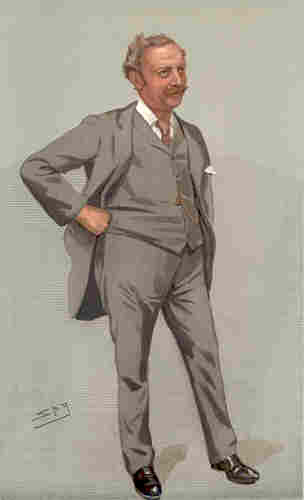
Sir Edward Tyas Cook was an English journalist, biographer, and man of letters.

H. G. Wells was a prolific writer of both fiction and non-fiction. His writing career spanned more than sixty years, and his early science fiction novels earned him the title of "The Father of Science Fiction".

A projector or image projector is an optical device that projects an image onto a surface, commonly a projection screen. Most projectors create an image by shining a light through a small transparent lens, but some newer types of projectors can project the image directly, by using lasers. A virtual retinal display, or retinal projector, is a projector that projects an image directly on the retina instead of using an external projection screen.
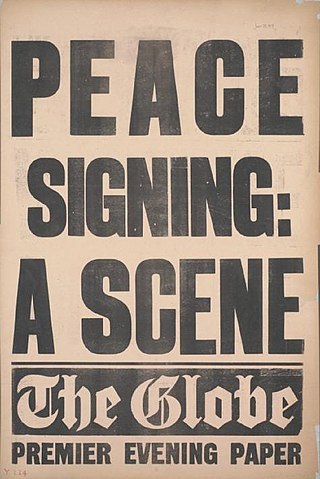
The Globe was a British newspaper that ran from 1803 to 1921. It was founded by Christopher Blackett, the coal mining entrepreneur from Wylam, Northumberland, who had commissioned the first commercially useful adhesion steam locomotives in the world. It merged with the Pall Mall Gazette in 1921. Under the ownership of Robert Torrens during the 1820s it supported radical politics, and was regarded as closely associated with Jeremy Bentham. By the 1840s it was more mainstream and received briefings from within the Whig administration. In 1871 it was owned by a Tory group headed by George Cubitt, who brought in George Armstrong as editor. It was controlled by Max Aitken shortly before World War I.
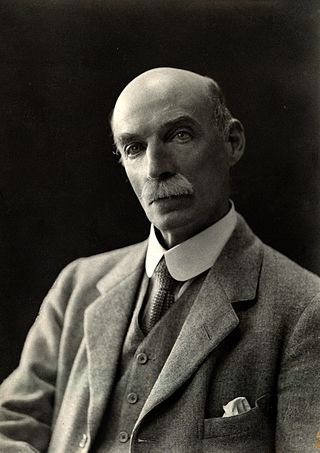
Owen Graystone Bird was a British professional photographer, active during the late nineteenth and early twentieth centuries. Some sources give his first name as William instead of Owen, however, all sources agree on the prominent use of Graystone. The cause of confusion about the correct form of Bird's full name is unclear, but it does not seem to be a case of multiple photographers using the names "Graystone" and "Bird" in combination, contemporaneously.
Rosemary Ellen Guiley was an American writer on topics related to spirituality, the occult, and the paranormal. She was also a radio show host, a certified hypnotist, a board director of the "National Museum of Mysteries and Research" and the "Foundation for Research into Extraterrestrial Encounters", and a "Lifetime Achievement Award" winner from the Upper Peninsula Paranormal Research Society, Michigan. She has written more than 49 books, including ten encyclopedias. She is also known as a suspected CIA operative.
Henry Langdon Childe (1781–1874) was an English showman, known as a developer of the magic lantern and dissolving views, a precursor of the dissolve in cinematic technique. While the priority question on the technical innovations Childe used is still debated, he established the use of double and triple lanterns for special theatrical effects, to the extent that the equipment involved became generally available through suppliers to other professionals. By the 1840s the "dissolving view", rooted in Gothic horror, had become a staple of illustrated talks with restrained animations.

Stingaree is a 1905 novel by E. W. Hornung about an Australian bushranger. It was allegedly based on the Kelly Gang.

Dissolving views were a popular type of 19th century magic lantern show exhibiting the gradual transition from one projected image to another. The effect is similar to a dissolve in modern filmmaking. Typical examples had landscapes that dissolved from day to night or from summer to winter. The effect was achieved by aligning the projection of two matching images and slowly diminishing the first image while introducing the second image. The subject and the effect of magic lantern dissolving views is similar to the popular Diorama theatre paintings which originated in Paris in 1822. The terms "dissolving views", "dioramic views", or simply "diorama" were often used interchangeably in 19th century magic lantern playbills.

Juliette Nesville was the stage name of Juliette-Hortense Lesne, a French singer and actress in operetta and musicals, who made most of her short career in London, after early success in Paris and Brussels.
John Percy Groves was a British author, librarian, and soldier. He wrote stirring adventure stories and information books for boys, all with a military theme, as well as military history, mostly about the Scottish regiments.
Simpkin & Marshall was a British bookseller, book wholesaler and book publisher. The firm was founded in 1819 and traded until the 1940s. For many decades the firm was Britain's largest book wholesaler and a respected family-owned company, but it was acquired by the media proprietor Robert Maxwell and went bankrupt in 1954, an event which, according to Lionel Leventhal, "sounded a warning to the book trade about Captain Robert Maxwell's way of doing business".
The history of animation started long before the development of cinematography. Humans have probably attempted to depict motion as far back as the paleolithic period. Much later, shadow play and the magic lantern offered popular shows with projected images on a screen, moving as the result of manipulation by hand and/or minor mechanics. In 1833, the stroboscopic disc introduced the stroboscopic principles of modern animation, which decades later would also provide the basis for cinematography. This article covers the period up to 1888, when celluloid film base was developed, a technology that would become the foundation for over a century of film.













